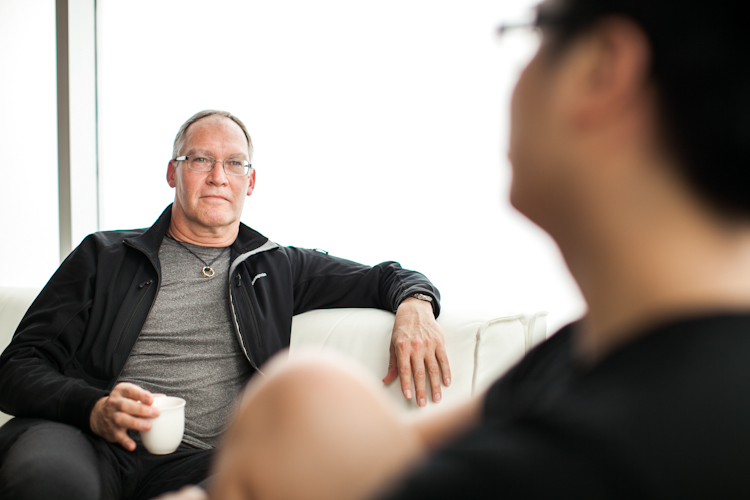Wake up your body in bed
It's already Monday! The weekend flew by and now your alarm is going off and it's time to get up and get to work. Don't stress. Before rushing to get dressed, brushing your teeth, and finding your way out the door. Set your alarm about 15 minutes earlier than you normally would and take that extra 15 minutes to do a few yoga poses while you're still laying in bed. Help your body wake up.
1. Lie on your back in Savasana, and come into Supta Badha Konasana (Reclined Butterfly).
Bring your foot soles to touch and allow your knees to fall open to either sides of the bed. You can keep your eyes closed and stretch your fingertips up towards the sky and allow them to gracefully fall behind your head. Take 10 deep breaths here to start waking up the body and the brain.
2. Supine Twist is next. So draw your knees back together, wrap your arms around your shins or thighs and give it a good squeeze. Then allow your knees to fall to the right, your right hand can rest on your knees and left hand reaches to the left. Gaze can go left if that is comfortable for your neck. Take 5 or more deep breaths here and then switch to the other side.
3. Now, it's time to sit up. Paschimottanasana (Forward fold) with both feet in front. Allow this forward fold to be passive and allow your head to be heavy. This helps calm the mind and improves concentration. Then slowly with as much ease as you can, begin to draw yourself back up stacking vertebrae upon vertebrae until you're fully upright. Then open your eyes, roll your head from side to side, and place your feet on the floor and get ready to start your day!
Let's Fly.
Arm balances are great for building strength and cultivating body awareness and focus. Our Power Upside Down Yogi, Lindsey, is a huge advocate for doing anything that require balancing on your hands. Take a look at Lindsey's awesome Crow Pose. Notice how strong and focused this Yoginis is!
HOW TO get into Crow: 1) Take your feet mat width apart and come into a squat. 2) Plant your palms firmly into the earth right underneath your shoulders. 3) Bend your elbows and find Chaturanga Arms. 4) Place your knees high up into your triceps and hug your knees into the midline. 5) Start to shift your balance forward into your hands as you take one foot off the floor and then the other. 6) Squeeze your feet together to find strength in your legs and stability in balance. 7) Allow your gaze to be in front of you to maintain stability.
Tips: 1) Your core strength is the most important! Building the strength in your core will help you go a long way when it comes to arm balances. 2) Chaturanga arms are crucial to Crow pose as well as many other Arm Balances. 3) Keep your knees hugging tightly into your body rather than allowing them to rest on your arms. This helps balance the weight between your legs and your arms 4) Keep squeezing your feet together to engage the muscles in your legs. This will help strengthen your core.
Tell us what your favourite arm balance is!
What is Yoga to me?
In a conversation with a friend I once described love as “water”. As we all know, water takes the shape of its container, and in my metaphor, I essentially explained that love takes the shape of the relationship you have with another person; so whether your relationship with another is intimate, or merely a friendship, love is still present, but in a different form. I know you’re asking the question in your head, “well what does this have to do with yoga?”
Relax... I’m getting there.
I’ve only been on this yoga journey, on and off, for 2 years but it has had a significant impact on how I deal with the world around me. Three years ago, I found myself stressing out over my first year of university. In the present day, I still stress out over school; it’s just that now, when I find myself lacking drive or energy, I’ll do a few sun salutations to get me back on track. Essentially, I use yoga to cleanse myself of things that are unnecessarily cluttering my mind. It was during a strong practice recently, that I realized the link between this mental de-cluttering and my (somewhat clever) analogy of love.
Yoga, to me, is a river. Like a river, yoga can be gentle enough to smooth the rough edges of a pebble, but powerful enough to carve an entire landscape; in other words, it can help us get through the little issues (like school stress) that come in everyday life, or it can truly change your entire outlook as a person.
Just like a river, in a yoga class we’re constantly active; whether it is the actual physical movement of a flow, or the constant stream of thoughts moving through our minds while we’re trying to keep our tree pose still, we’re always dynamic. While some try to suppress this mental movement, I’ve realized now that the only way to get through a class smoothly is to embrace these thoughts, acknowledge them, and move on.
Most importantly, yoga and rivers share the same endpoint. While rivers are always running, they will, at some point, end in a larger body of water, like an ocean. Relative to the river, these larger bodies of water are quite still, and although they do move, they move on a larger, more profound scale.
In yoga, while we may not be able to completely detach ourselves from the happenings that occur off the mat, the eventual destination is a place of stillness that is deeper than the shallow, and sometimes rocky movement of our practice; the endpoint is the ocean to our river. The changes that occur when we reach that stillness, like the waves of an ocean, are much more profound and have a greater impact on who we are, compared to the small waves of thought that may occur during our practice. In my mind, this is why instructors always say that savasana is the hardest, but most important pose of that entire hour, despite its simplicity. While no two classes are ever the same, having this understanding of where I’m trying to end up adds some consistency to my entire practice. On the larger scale, I will always be seeking stillness.
"Your innermost sense of self, of who you are, is inseparable from stillness. This is the I Am that is deeper than name and form." - Eckhart Tolle
In spite of this long-winded explanation, all this talk of rivers, love and yoga can be illustrated in a simple equation.
Love = Water.
Yoga = Moving Water.
Therefore Yoga = Moving Love.
That’s exactly what yoga is to me. It’s a moving expression of our affection for ourselves, which allows us the opportunity of real transformation. It’s an hour to shape our proverbial container and create a relationship with ourselves, so that we can fully express our love in a way that is uniquely contoured to who we are. It’s a set of postures and breaths that are all trying to move us towards stillness. When we reach that point, even if it’s only for a brief moment, we realize that it is in stillness that real changes happen.
Categories
- Recipe 11
- Wellness 241
- Zen Habits & Inspiration 100
- Injury Prevention & Health 30
- Classes 1
- Yogalife Classes 7
- Prop Specific 1
- Studio Information 17
- Foundation Friday 25
- Physical Health 3
- Yoga Specific 54
- Curated Playlists 2
- Karma Program 5
- Staff Adventures & Journeys 10
- Anatomy & Information 30
- Community Event 15
- YEG Highlight 8
- Instructor Stories 22
- Yogi of the Month 13
- What's Going On 35
- Yogalife Workshops, Retreats & Trainings 37
- Relaxation 1
- Mental Health 2
- Workshops 34
- Registered Classes 4
- Pregnancy & Family 1
- Member Stories 5







